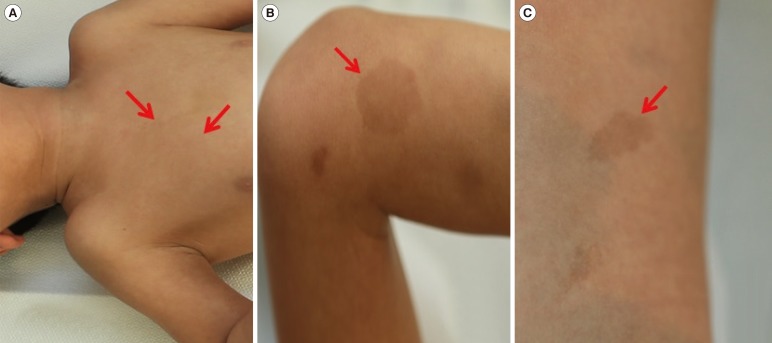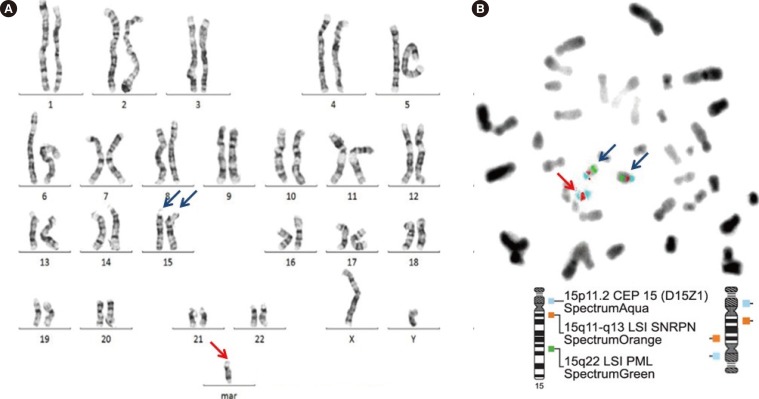Ann Lab Med.
2015 Jul;35(4):474-476. 10.3343/alm.2015.35.4.474.
Isodicentric Chromosome 15 Syndrome in a Korean Patient With Cafe-au-lait Spots
- Affiliations
-
- 1Department of Laboratory Medicine, Severance Hospital, Yonsei University College of Medicine, Seoul, Korea. CJR0606@yuhs.ac
- 2Department of Pediatrics, Severance Hospital, Yonsei University College of Medicine, Seoul, Korea.
- KMID: 2045876
- DOI: http://doi.org/10.3343/alm.2015.35.4.474
Abstract
- No abstract available.
Figure
Reference
-
1. Battaglia A. The inv dup (15) or idic (15) syndrome (Tetrasomy 15q). Orphanet J Rare Dis. 2008; 3:30. PMID: 19019226.
Article2. Woo HY, Cho HJ, Kong SY, Kim HJ, Jeon HB, Kim EC, et al. Marker chromosomes in Korean patients: incidence, identification and diagnostic approach. J Korean Med Sci. 2003; 18:773–778. PMID: 14676430.
Article3. Kim JS, Park J, Min BJ, Oh SK, Choi JS, Woo MJ, et al. A case of isodicentric chromosome 15 presented with epilepsy and developmental delay. Korean J Pediatr. 2012; 55:487–490. PMID: 23300505.
Article4. Park DH, Lim S, Park ES, Sim EG. A nine-month-old boy with isodicentric chromosome 15: a case report. Ann Rehabil Med. 2013; 37:291–294. PMID: 23705128.
Article5. Conant KD, Finucane B, Cleary N, Martin A, Muss C, Delany M, et al. A survey of seizures and current treatments in 15q duplication syndrome. Epilepsia. 2014; 55:396–402. PMID: 24502430.
Article6. Rineer S, Finucane B, Simon EW. Autistic symptoms among children and young adults with isodicentric chromosome 15. Am J Med Genet. 1998; 81:428–433. PMID: 9754629.
Article7. Simic M, Turk J. Autistic spectrum disorder associated with partial duplication of chromosome 15; three case reports. Eur Child Adolesc Psychiatry. 2004; 13:389–393. PMID: 15619052.
Article8. Shah KN. The diagnostic and clinical significance of café-au-lait macules. Pediatr Clin North Am. 2010; 57:1131–1153. PMID: 20888463.
Article9. Nyström AM, Ekvall S, Strömberg B, Holmström G, Thuresson AC, Annerén G, et al. A severe form of Noonan syndrome and autosomal dominant café-au-lait spots - evidence for different genetic origins. Acta Paediatr. 2009; 98:693–698. PMID: 19120036.
Article10. Rosado LAM, Mariño TC, Ávila TG, Gil JH, Martínez AB. The inv dup (15) or idic (15) syndrome: a case report. Rev Cubana Genet Comunit. 2012; 6:61–63.
- Full Text Links
- Actions
-
Cited
- CITED
-
- Close
- Share
- Similar articles
-
- A Case of Segmental Neurofibromatosis
- Histopathological Observation of Cafe au Lait Spots
- A Case of Multiple Cafe-au-lait Spots with Nevus Depigmentosus and Hemangioma
- Congenital Café-au-Lait Spot and Sequentially Occurred Nevus Spilus
- A Case of Juvenile Xanthogranuloma Associated with Juvenile Chronic Myeloid Leukemia and Neurofibromatosis



